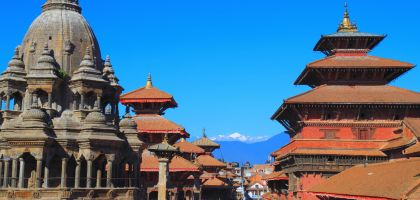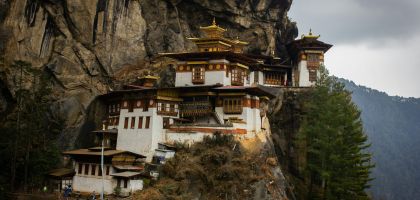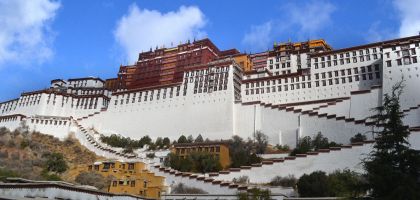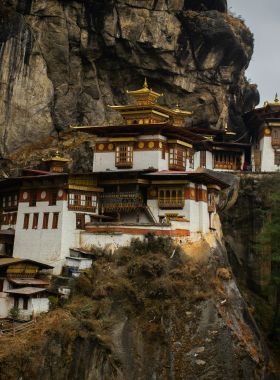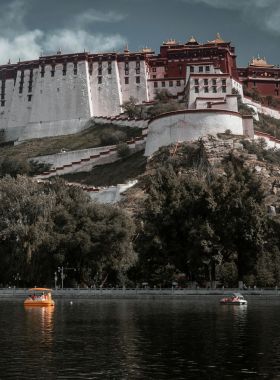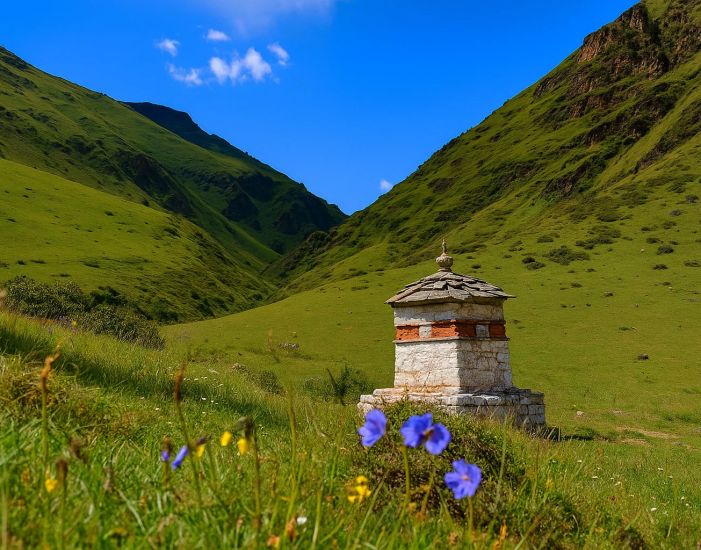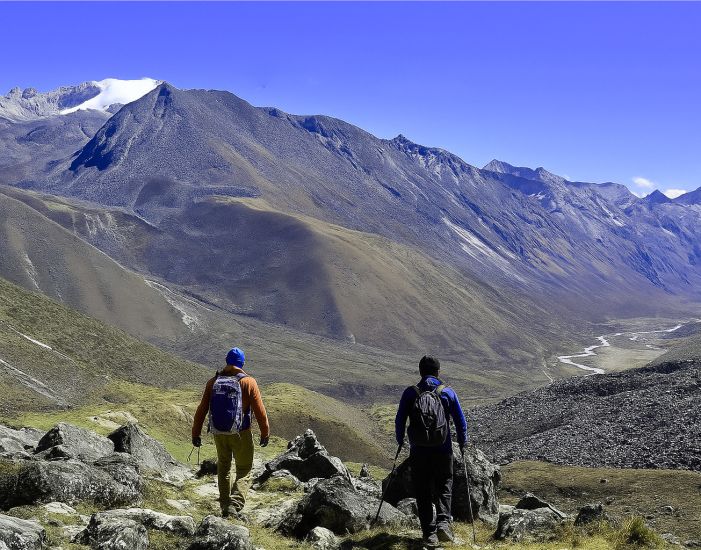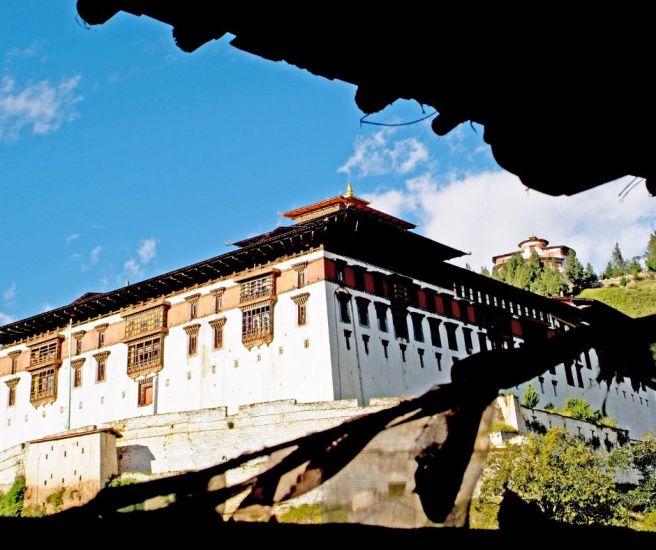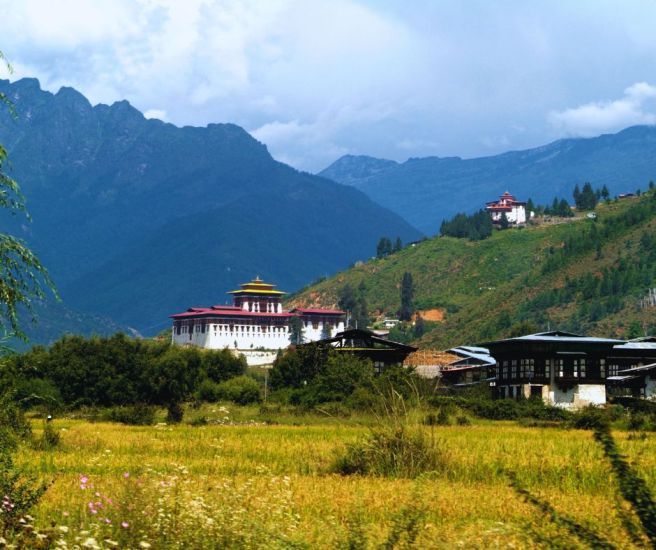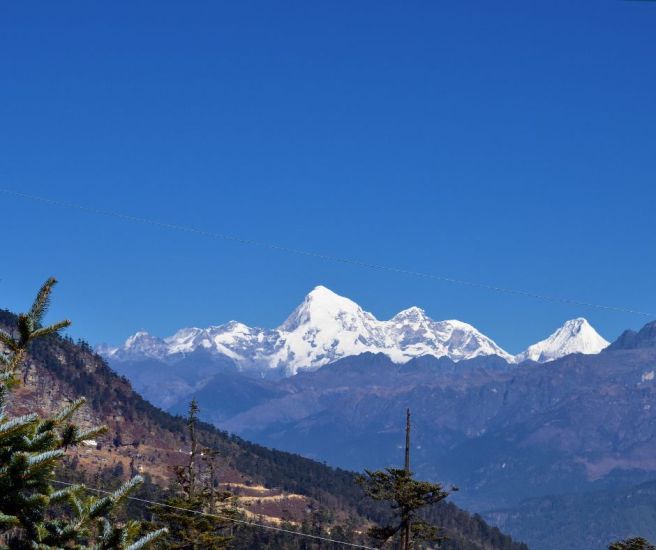Jomolhari Mountain Trek
14 Days / Bhutan
Activity
Difficulty Level
Destinations
Trip Start / End
Accommodation
Travel Style
Best time to travel
Personalized Travel Advice

Dev Raj Nepal
+977 9851096523
Detailed Itinerary
01
DAY
01
Upon your arrival at Paro International Airport, you will be warmly welcomed by your guide who will assist with your transfer to your hotel. After settling into your comfortable accommodation, enjoy a traditional Bhutanese lunch to energize you for the day ahead. In the afternoon, take a leisurely stroll around Paro town. The charming streets offer a delightful mix of traditional Bhutanese houses, small markets, and quaint shops selling local goods. This is a perfect opportunity to acclimatize to the altitude while immersing yourself in the peaceful atmosphere of Bhutan’s beautiful countryside
Arrival at Paro
Upon your arrival at Paro International Airport, you will be warmly welcomed by your guide who will assist with your transfer to your hotel. After settling into your comfortable accommodation, enjoy a traditional Bhutanese lunch to energize you for the day ahead. In the afternoon, take a leisurely stroll around Paro town. The charming streets offer a delightful mix of traditional Bhutanese houses, small markets, and quaint shops selling local goods. This is a perfect opportunity to acclimatize to the altitude while immersing yourself in the peaceful atmosphere of Bhutan’s beautiful countryside
02
DAY
02
Today, you will immerse yourself in the rich cultural heritage and history of Paro Valley. Begin with a visit to the imposing Drukgyel Dzong, a historic fortress that once defended the valley against Tibetan invasions. Though now in ruins, the Dzong offers a spectacular view of Mount Jomolhari in the distance. Next, head to the National Museum (Ta Dzong), perched above the valley. The museum’s fascinating collection showcases Bhutan’s unique art, artifacts, and cultural history. Proceed to Rinpung Dzong, also known as Paro Dzong, a massive and beautifully decorated structure that serves as both a monastery and an administrative center. Conclude your day with a visit to the local market where you can browse through colorful handicrafts, textiles, and other traditional Bhutanese items.
Explore Paro Valley
Today, you will immerse yourself in the rich cultural heritage and history of Paro Valley. Begin with a visit to the imposing Drukgyel Dzong, a historic fortress that once defended the valley against Tibetan invasions. Though now in ruins, the Dzong offers a spectacular view of Mount Jomolhari in the distance. Next, head to the National Museum (Ta Dzong), perched above the valley. The museum’s fascinating collection showcases Bhutan’s unique art, artifacts, and cultural history. Proceed to Rinpung Dzong, also known as Paro Dzong, a massive and beautifully decorated structure that serves as both a monastery and an administrative center. Conclude your day with a visit to the local market where you can browse through colorful handicrafts, textiles, and other traditional Bhutanese items.
03
DAY
03
Your adventure truly begins today as you embark on your first trek to Shana. The hike will take you through beautiful landscapes, with forests of pine and oak, along the Paro River, and through peaceful valleys dotted with traditional Bhutanese farmhouses. As you approach your campsite at 9,184 feet (2,800 meters), you will be surrounded by lush greenery and the soothing sounds of nature. This peaceful and serene environment provides the perfect opportunity to rest and unwind.
Trek to Shana
Your adventure truly begins today as you embark on your first trek to Shana. The hike will take you through beautiful landscapes, with forests of pine and oak, along the Paro River, and through peaceful valleys dotted with traditional Bhutanese farmhouses. As you approach your campsite at 9,184 feet (2,800 meters), you will be surrounded by lush greenery and the soothing sounds of nature. This peaceful and serene environment provides the perfect opportunity to rest and unwind.
04
DAY
04
Today’s trek will take you further into the heart of Bhutan’s wilderness as you head towards Soi Thangthangka. The trail spans 10 miles and takes you through alpine meadows, dense forests, and across small streams. As you gain altitude, you’ll be treated to stunning views of snow-capped peaks and the vastness of the surrounding landscape. The campsite at 11,480 feet (3,500 meters) provides a tranquil setting, with a panoramic view of the mountain ranges. Spend the evening in the serenity of the Bhutanese wilderness, enjoying the clear, crisp mountain air.
Trek to Soi Thangthangka
Today’s trek will take you further into the heart of Bhutan’s wilderness as you head towards Soi Thangthangka. The trail spans 10 miles and takes you through alpine meadows, dense forests, and across small streams. As you gain altitude, you’ll be treated to stunning views of snow-capped peaks and the vastness of the surrounding landscape. The campsite at 11,480 feet (3,500 meters) provides a tranquil setting, with a panoramic view of the mountain ranges. Spend the evening in the serenity of the Bhutanese wilderness, enjoying the clear, crisp mountain air.
05
DAY
05
Today, you’ll trek to Jangothang, the base camp of the iconic Mount Jomolhari. The journey covers about 12 miles. As you hike higher, you’ll cross alpine meadows and reach a stunning landscape of glaciers, streams, and towering peaks. Upon reaching 13,251 feet (4,040 meters), the campsite offers a breathtaking view of Mount Jomolhari and its surrounding ridges, which form a majestic backdrop to your camp. This is one of the most awe-inspiring spots in the region, with panoramic views of the mountains and the valleys below.
Trek to Jangothang
Today, you’ll trek to Jangothang, the base camp of the iconic Mount Jomolhari. The journey covers about 12 miles. As you hike higher, you’ll cross alpine meadows and reach a stunning landscape of glaciers, streams, and towering peaks. Upon reaching 13,251 feet (4,040 meters), the campsite offers a breathtaking view of Mount Jomolhari and its surrounding ridges, which form a majestic backdrop to your camp. This is one of the most awe-inspiring spots in the region, with panoramic views of the mountains and the valleys below.
06
DAY
06
Today is a rest day, essential for acclimatization to the high altitude of Jangothang. Spend the day exploring the stunning surroundings, with optional short hikes to nearby glacial lakes that reflect the towering snow-capped peaks. The serene beauty of this area is unmatched, and it’s a perfect opportunity to capture the landscape in photographs or simply enjoy the peaceful atmosphere. Take time to relax and prepare for the more challenging trekking days ahead.
Rest and Acclimatization at Jangothang
Today is a rest day, essential for acclimatization to the high altitude of Jangothang. Spend the day exploring the stunning surroundings, with optional short hikes to nearby glacial lakes that reflect the towering snow-capped peaks. The serene beauty of this area is unmatched, and it’s a perfect opportunity to capture the landscape in photographs or simply enjoy the peaceful atmosphere. Take time to relax and prepare for the more challenging trekking days ahead.
07
DAY
07
The trek to Lingshi will take you through some of the most stunning landscapes in Bhutan. The trail covers about 13 miles, winding through ridges and offering panoramic views of the peaks of the Himalayas. As you continue your hike, you will experience a gradual ascent, and the campsite at 13,612 feet (4,150 meters) offers an incredible view of the surrounding rugged mountains and valleys. Lingshi is a small village known for its traditional stone houses, and the peaceful setting will give you the opportunity to connect with nature and the Bhutanese way of life.
Trek to Lingshi
The trek to Lingshi will take you through some of the most stunning landscapes in Bhutan. The trail covers about 13 miles, winding through ridges and offering panoramic views of the peaks of the Himalayas. As you continue your hike, you will experience a gradual ascent, and the campsite at 13,612 feet (4,150 meters) offers an incredible view of the surrounding rugged mountains and valleys. Lingshi is a small village known for its traditional stone houses, and the peaceful setting will give you the opportunity to connect with nature and the Bhutanese way of life.
08
DAY
08
Today’s trek is one of the more challenging legs of your journey. Today’s hike will be a little strenuous as we will be covering 14 miles, and ascend to the Yalila Pass at 15,810 feet (4,820 meters) before descending to your camp at 12,999 feet (3,963 meters). The views of Mount Jomolhari and the surrounding peaks will leave you in awe, and the descent through alpine meadows will provide much-needed relief after the challenging climb. The campsite offers stunning views of the surrounding valleys and is a perfect place to relax under the stars.
Trek to Shodu
Today’s trek is one of the more challenging legs of your journey. Today’s hike will be a little strenuous as we will be covering 14 miles, and ascend to the Yalila Pass at 15,810 feet (4,820 meters) before descending to your camp at 12,999 feet (3,963 meters). The views of Mount Jomolhari and the surrounding peaks will leave you in awe, and the descent through alpine meadows will provide much-needed relief after the challenging climb. The campsite offers stunning views of the surrounding valleys and is a perfect place to relax under the stars.
09
DAY
09
This day will be a bit easier, as we cover a distance of approximately 8 miles. The descent through rhododendron and birch forests is beautiful, and you’ll pass through peaceful valleys before reaching your camp at 12,415 feet (3,785 meters). This location offers a tranquil setting surrounded by natural beauty, and you’ll have a chance to unwind and enjoy the peaceful environment.
Trek to Barshong
This day will be a bit easier, as we cover a distance of approximately 8 miles. The descent through rhododendron and birch forests is beautiful, and you’ll pass through peaceful valleys before reaching your camp at 12,415 feet (3,785 meters). This location offers a tranquil setting surrounded by natural beauty, and you’ll have a chance to unwind and enjoy the peaceful environment.
10
DAY
10
Today’s trek is relatively short, covering 7.5 miles of a mountainous terrain. You’ll pass through thick forests and grassy meadows, gradually making your way toward Dolam Kencho. At 11,900 feet (3,628 meters), the campsite provides a peaceful location surrounded by the beauty of the Himalayas. Enjoy the serene atmosphere, take in the views, and rest before your final days of trekking.
Trek to Dolam Kencho
Today’s trek is relatively short, covering 7.5 miles of a mountainous terrain. You’ll pass through thick forests and grassy meadows, gradually making your way toward Dolam Kencho. At 11,900 feet (3,628 meters), the campsite provides a peaceful location surrounded by the beauty of the Himalayas. Enjoy the serene atmosphere, take in the views, and rest before your final days of trekking.
11
DAY
11
The final stretch of the trek takes you on a 9-mile hike for 4–5 hours, descending through a small pass and offering great opportunities for spotting monkeys in the surrounding forests. After reaching the road, you’ll be transferred to Thimphu, Bhutan’s vibrant capital. Spend the evening at leisure, perhaps enjoying a traditional Bhutanese meal in the city.
Trek to Thimphu
The final stretch of the trek takes you on a 9-mile hike for 4–5 hours, descending through a small pass and offering great opportunities for spotting monkeys in the surrounding forests. After reaching the road, you’ll be transferred to Thimphu, Bhutan’s vibrant capital. Spend the evening at leisure, perhaps enjoying a traditional Bhutanese meal in the city.
12
DAY
12
Today, we begin our exploration of Thimphu with a visit to Buddha Dordenma, an enormous golden statue seated atop a hill overlooking the valley. Standing at 51 meters, this majestic statue is one of the largest Buddha statues in the world and houses thousands of smaller Buddha statues inside. The site offers panoramic views of Thimphu, making it a perfect start to the day.
Next, we visit the Memorial Chorten, a sacred stupa built in honor of Bhutan’s third king, Jigme Dorji Wangchuck. Locals circumambulate the chorten, spinning prayer wheels and offering prayers, creating a deeply spiritual atmosphere. Afterward, we proceed to the National Institute for Zorig Chusum, commonly known as the School of Traditional Arts, where students meticulously practice Bhutan’s 13 traditional arts, including painting, wood carving, and embroidery.
From there, we explore the Folk Heritage Museum, housed in a traditional Bhutanese farmhouse. This living museum offers an immersive experience into rural Bhutanese life, displaying household artifacts, farming tools, and an authentic setting that showcases how Bhutanese families have lived for centuries.
To conclude our day, we visit Changangkha Lhakhang, one of the oldest temples in Thimphu, perched on a ridge overlooking the city. This temple is a spiritual haven for Bhutanese parents who bring their newborns for blessings, and it offers stunning views of the valley below.
Sightseeing in Thimphu
Today, we begin our exploration of Thimphu with a visit to Buddha Dordenma, an enormous golden statue seated atop a hill overlooking the valley. Standing at 51 meters, this majestic statue is one of the largest Buddha statues in the world and houses thousands of smaller Buddha statues inside. The site offers panoramic views of Thimphu, making it a perfect start to the day.
Next, we visit the Memorial Chorten, a sacred stupa built in honor of Bhutan’s third king, Jigme Dorji Wangchuck. Locals circumambulate the chorten, spinning prayer wheels and offering prayers, creating a deeply spiritual atmosphere. Afterward, we proceed to the National Institute for Zorig Chusum, commonly known as the School of Traditional Arts, where students meticulously practice Bhutan’s 13 traditional arts, including painting, wood carving, and embroidery.
From there, we explore the Folk Heritage Museum, housed in a traditional Bhutanese farmhouse. This living museum offers an immersive experience into rural Bhutanese life, displaying household artifacts, farming tools, and an authentic setting that showcases how Bhutanese families have lived for centuries.
To conclude our day, we visit Changangkha Lhakhang, one of the oldest temples in Thimphu, perched on a ridge overlooking the city. This temple is a spiritual haven for Bhutanese parents who bring their newborns for blessings, and it offers stunning views of the valley below.
13
DAY
13
A scenic 2.5-hour drive back to Paro allows you to soak in the beauty of the Bhutanese countryside one last time. Upon arrival, you’ll have time for a leisurely afternoon, perhaps visiting the famous Tiger’s Nest Monastery (Paro Taktsang) if you’re feeling adventurous. This iconic monastery is perched on a cliffside, offering dramatic views of the valley.
Drive to Paro
A scenic 2.5-hour drive back to Paro allows you to soak in the beauty of the Bhutanese countryside one last time. Upon arrival, you’ll have time for a leisurely afternoon, perhaps visiting the famous Tiger’s Nest Monastery (Paro Taktsang) if you’re feeling adventurous. This iconic monastery is perched on a cliffside, offering dramatic views of the valley.
14
DAY
14
After a final breakfast, you’ll be transferred to Paro International Airport for your flight back home, leaving with unforgettable memories of your Bhutanese adventure.
Departure from Paro
After a final breakfast, you’ll be transferred to Paro International Airport for your flight back home, leaving with unforgettable memories of your Bhutanese adventure.
Includes / Excludes
Inclusions
-
All camping gears that includes – 2 person sleeping tent with floors and fly sheet, dinning tent, kitchen tent, toilet tents, dining tables, chairs, pillows and mattresses.
-
A level accommodation on twin sharing basis while in the cities.
-
English speaking Guide.
-
Cook and kitchen aides.
-
All intercity transfers and sightseeing by a private vehicle.
-
Pack animals and animal drivers during trekking.
-
All necessary supplies.
-
3 meals a day.
-
Bhutan visa processing.
-
Sightseeing admission fees.
-
Bhutan visa fee
Exclusions
-
Airfare into and out of Bhutan.
-
Travel Insurance and emergency evacuation.
-
Expenses of personal nature like drinks, tip, telephone, laundry etc.
-
Extra expenses due to nature or unforeseen events such as flight cancellation, road blockade, no show etc.
Trip Info
The best time to experience this trek is from March to May and September to November. During these months, Bhutan’s high-altitude valleys and trails come alive with clear skies, vibrant colors, and mild weather, making it ideal for trekking.
Spring (March to May) brings a spectacular bloom of rhododendrons, magnolias, and wildflowers, painting the landscape with color. The weather is generally mild, with warm days and cool nights, perfect for enjoying the breathtaking views of Bumthang’s lush valleys and forested hillsides.
Autumn (September to November) is another stunning season, offering crisp, clear skies and fresh mountain air. This time of year is celebrated for its harvest festivals, making it an ideal period to witness Bumthang’s unique cultural traditions alongside its natural beauty. The warm days and cooler nights during autumn also provide optimal trekking conditions.
While winter (December to February) offers solitude and snowy landscapes, it can be very cold, particularly at night. Summer (June to August) brings monsoon rains, which may make trails muddy and less accessible. For the best experience on the Bumthang Cultural Trek, plan your visit in spring or autumn to enjoy Bhutan’s warm hospitality, stunning landscapes, and vibrant culture at their finest.
For this tour, we prioritize both comfort and safety by providing well-maintained vehicles suited to the group size. If the group consists of fewer than 8 participants, we will use a high-roof Toyota HiAce, a spacious and reliable vehicle with ample legroom and luggage space. For groups larger than 8, we will upgrade to a Mini-bus, ensuring everyone has a comfortable and enjoyable journey together.
Our drivers are highly experienced professionals with extensive knowledge of the routes, terrain, and road conditions. They are trained in defensive driving and safety protocols, ensuring a smooth and secure travel experience. With years of experience navigating mountain roads and varying weather conditions, they prioritize passenger safety while maintaining a steady and comfortable ride.
Additionally, our vehicles undergo regular maintenance and safety checks to ensure reliability throughout the journey. Whether winding through mountain passes or traveling along scenic valleys, you can rest assured that your transportation is in capable hands, allowing you to fully enjoy the beauty of the destination without any worries.
Most parts of this trek will take you to the remote regions of Bhutan. Therefore, there is a scarcity of luxurious accommodations. At regional centers and big towns like Paro and Thimphu, we provide high grade hotels that provide comfort and warmth. However, during the trek, the accommodations are primarily in tents, where trekkers camp in designated spots at various points along the trail. These campsites are typically set up in meadows or near small villages, offering trekkers a chance to experience the beauty of the highlands up close. The camps are equipped with basic facilities like sleeping tents and shared dining tents, where meals are served. In some places, trekkers can stay in simple guesthouses or hotels that provide comfort before and after the trek. The accommodations are functional and designed to complement the trekking experience, offering a cozy respite after a long day on the trail.
Food on this typical Bhutan trek is mostly simple but nutritious, designed to provide energy for the long days of trekking. In the villages and towns, meals are typically served at local guesthouses, where you’ll find traditional Bhutanese dishes such as ema datshi (a spicy cheese and chili dish) and phaksha paa (pork with radishes). During the trek, meals are often prepared by the trek crew, including porters and cooks, and served at the campsites. Expect to have a variety of hearty, locally sourced food, such as rice, vegetables, lentils, and noodles. Breakfast may include porridge, eggs, and bread, while dinners often consist of stews and curries. Given the high-altitude conditions, hydration is crucial, and water is regularly provided during the trek, though it’s recommended to drink purified water.
Clothing
- Light layers: T-shirts, long-sleeve shirts, and a couple of warm sweaters or fleeces.
- Thermal wear: Necessary for high-altitude areas and trekking days (especially for evenings).
- Outerwear: Warm, windproof jacket; waterproof jacket or poncho (for unexpected rain).
- Pants: Comfortable trekking pants and a few pairs of casual pants for cultural sites and town visits.
- Comfortable shoes: Hiking boots for trekking and sturdy, comfortable walking shoes for towns.
- Warm socks: Especially for trekking days at higher altitudes.
Accessories
- Hat, gloves, and scarf
- Sun hat and sunglasses
- Light daypack
- Trekking poles
- Quick-dry towel
Personal Items
- Toiletries: Soap, shampoo, toothbrush, toothpaste, and other personal hygiene items.
- Sunscreen and lip balm: High SPF for sun protection at high altitudes.
- Moisturizer: Dry weather may affect the skin.
- Hand sanitizer and wet wipes: For cleanliness on the go.
- First aid kit: Basic items like band-aids, pain relievers, blister treatment, altitude sickness medication (consult a doctor before traveling).
- Insect repellent: For rural areas.
Trekking Essentials
- Reusable water bottle
- Water purification tablets
- Energy snacks
- Headlamp or flashlight
Cultural Considerations
- Modest clothing: Long pants and long-sleeved shirts are preferred for monastery visits.
- Shawl or scarf: Useful when entering temples or Dzongs.
- Reusable bags: For storing and organizing belongings.
Risks
Altitude Sickness and Fatigue
As you venture above 3,000 meters, the risk of altitude sickness increases. Symptoms such as headaches, dizziness, nausea, and breathlessness may occur, requiring prompt action to avoid serious health issues. The Jomolhari Trek is physically demanding, with long days of hiking through rugged terrain. This can lead to exhaustion, muscle strain, and joint pain, especially for those not accustomed to strenuous treks.
Unpredictable Weather and Remoteness
The weather in the Himalayas is notoriously unpredictable. Sudden rain, snow, or drops in temperature can make trekking more difficult and dangerous, with slippery trails and increased risk of exposure-related issues like hypothermia. Much of the trek passes through remote, isolated areas with limited access to medical facilities. In the event of an injury or illness, evacuation could be difficult, time-consuming, and potentially risky.
Rewards
Breathtaking Scenic Beauty and Culture
This trek in Bhutan presents awe-inspiring views of snow-capped peaks, lush valleys, alpine meadows, and crystal-clear lakes. Each day offers new vistas of Bhutan’s pristine natural landscapes, making the journey unforgettable. Along the trek, you’ll visit traditional Bhutanese villages, monasteries, and farms, providing a unique opportunity to experience Bhutanese culture, hospitality, and customs firsthand. Additionally, Visiting monasteries such as Talakha Goempa and experiencing Bhutan’s tranquil spiritual atmosphere can be deeply fulfilling. Many trekkers find the journey a spiritually enriching experience that connects them to the land.
Challenges and Achievement
Successfully completing this challenging multi-day trek in Bhutan at high altitudes offers a tremendous sense of achievement, improving physical fitness and boosting mental resilience. Overcoming difficult terrain tests your limits and builds confidence. Completing the Jomolhari Trek is a major accomplishment. The challenges you overcome and the beauty you witness make this journey one of Bhutan’s most rewarding and satisfying trekking routes.
Unique Wildlife and Flora and Serenity
Trekking in Bhutan offers a rare opportunity to view alpine flora like the Blue Poppy and diverse wildlife, including mountain birds. The biodiversity of the region enhances your trekking experience, offering a chance to witness Bhutan’s natural beauty. The Jomolhari Trek offers unparalleled peace and serenity, allowing you to disconnect from the rush of modern life. The calming atmosphere of the Himalayas invites reflection and rejuvenation in a truly serene environment.
Scenic Beauty and Cultural Encounters
This trek in Bhutan offers stunning landscapes, including alpine meadows, lush valleys, and towering snow-capped peaks. You’ll be surrounded by some of Bhutan’s most beautiful vistas, with Jomolhari towering above. Along the way, you’ll experience authentic Bhutanese culture by visiting traditional villages, monasteries, and farms. The warmth and hospitality of the locals will add a cultural richness to your journey, enhancing the overall experience of the Jomolhari Mountain Trek in Bhutan.
Physical and Mental Challenge
The Jomolhari Trek in Bhutan is a physically demanding adventure, with long days of hiking over rugged terrain. You will traverse steep ascents and descents, testing your endurance and strength. While the trek is moderately challenging, it is immensely rewarding. The altitude will also play a role in the trek’s difficulty, so acclimatization is crucial. You’ll face both physical fatigue and mental challenges, but the sense of accomplishment you’ll feel upon completing each section makes the effort worthwhile.
Remote and Peaceful Environment
This trek in Bhutan takes you through isolated regions, where you’ll experience peace and tranquility away from the bustling world. In these remote areas, you’ll find serenity in nature, camping in scenic spots surrounded by mountains. The isolation allows for a deeper connection with the environment and provides a chance for reflection. Expect quiet, breathtaking nights under the stars, offering a truly peaceful escape into the heart of Bhutan’s wilderness.
Unpredictable Weather and Wildlife
The weather in the Himalayas is unpredictable, with sudden temperature changes and potential rain or snow. Prepare for varying weather conditions by bringing layers and waterproof gear. Along the route, you’ll also have the chance to spot wildlife like yaks and mountain birds, as well as rare alpine flora such as Blue Poppies. Although encounters with wild animals are rare, you’ll be immersed in Bhutan’s unique biodiversity, adding to the trek’s charm.
FAQs
Personalized Travel Advice

Dev Raj Nepal
+977 9851096523
